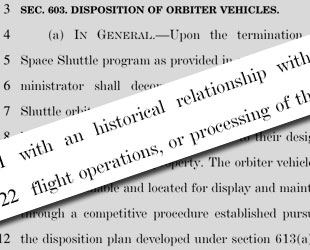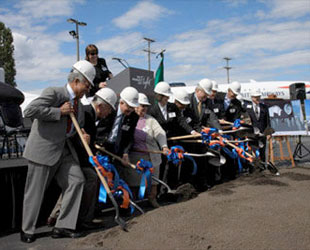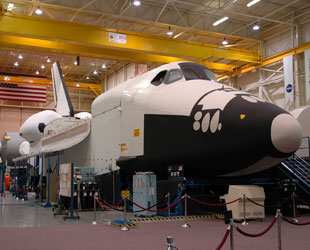August 2, 2010 — NASA waved off revealing where its soon-to-be-retired space shuttles will be making their final landing for public exhibit.
A combinations of events, including delayed launch dates and congressional acts that proposed adding at least one more mission to the two shuttle flights remaining, resulted in the space agency postponing its selection of museums where its orbiters will go on display after they are retired.
A July announcement on the final homes for the shuttles had been anticipated since January of this year, when the space agency made a last call for shuttle suitors.
"They haven't established a new date," NASA spokesman Mike Curie told collectSPACE. "Because of delays to the manifest, shifting STS-133 to November and STS-134 to February, the announcement was also delayed."
NASA had originally intended to retire its shuttle fleet -- Discovery, Atlantis and Endeavour -- by the end of 2010, but more time was needed to process the payloads for its final two planned missions.

Updated! Photo Gallery: How to display a retired orbiter
Space shuttle Discovery, which has been promised to the Smithsonian since 2008, was slated to fly its last flight, STS-133, in September but more time was required to prepare the storage module it will add to the International Space Station.
Endeavour, which together with shuttle Atlantis remains to be assigned to a museum, was set to fly in the November time-frame that Discovery will now launch. Its flight with the Alpha Magnetic Spectrometer, is now targeted for no earlier than February 2011.
For the 21 organizations NASA says are in the running for an orbiter, the delay has given rise to what appears to be a heightened sense of competition, with the rate of press releases, petitions and dedicated websites increasing and even a ground breaking for a facility to display a hopefully awarded shuttle.
The museums and NASA visitor centers have also turned to their states' congressmen, adding an additional political component to the decision that the space agency needs to now also take into consideration.
"That will have to sort itself out as well," said Curie.
Priority consideration vs. competition
When the Senate Committee on Commerce, Science and Transportation released its approved text for the NASA Authorization Act of 2010 on July 15, it included a section devoted to the "disposition of orbiter vehicles."
The bill, which was championed by senators from Florida and Texas, went beyond directing the NASA Administrator to decommission the shuttle fleet in a means consistent with other surplus government property. It also specifically gave "priority consideration" to museums located in areas sharing "an historical relationship with either the launch, flight operations, or processing" of the orbiters.

Should an historical relationship to shuttle flight operations be a priority deciding where to the orbiters are retired? (Senate) |
That provision amounted to Florida and Texas trying to make an "end run" around NASA's competitive process, according to the National Aviation Heritage Alliance of Dayton, Ohio. The non-profit organization, which members include the National Museum of the U.S. Air Force as well as other Ohio-area aviation sites, urged elected officials to change the text before the House of Representatives could adopt similar language.
So when the House Science and Technology Committee finalized the text of its companion bill on July 22, the wording had been amended. Though still making mention of an historical relationship with the space shuttle orbiters, the House called for a competitive process "that takes into account geographical diversity."
"With the help of the entire delegation it was possible to have the amendment pass and ensure that a decision will be made that reflects the entire contributions of the nation to the shuttle program and not just those of two states," said John Bosch, chair of the National Aviation Heritage Alliance, in a statement. "We recognize this remains a very competitive process and that's how it should be until a final decision is made by NASA."
Even when the decision is ultimately made, the chosen museums may still need to wait longer to receive a shuttle due to a provision agreed upon in both the House and Senate bills. Both chambers called for the addition of a shuttle mission to NASA's manifest to fly no earlier than June 2011.
The bills need to voted on by the full Senate and House -- now not expected until September -- before their differing texts can be worked out in conference and the act can be passed into law.
Signatures and shovels for shuttles
Not everyone is waiting on Congress.
Museums in Florida, Texas, Ohio and elsewhere continue to step up their public campaigns to bring a space shuttle to their facility.
Space Center Houston's "Bring the Shuttle Home" petition campaign, which began in July, has to date nearly 15,000 signatures on letters and e-mails urging President Obama to support displaying a retired orbiter at NASA's Johnson Space Center in Texas.
The Intrepid Sea, Air and Museum in New York City has collected over 128,000 signatures since March supporting landing a shuttle on -- or at least next to -- the modified aircraft carrier-turned-museum.
The Museum of Flight in Seattle, Washington launched a similar petition effort recently but also traded their pens for shovels, breaking ground June 29 for the construction of a new $12 million, 15,500-square-foot "Human Space Flight Gallery" designed to showcase a shuttle, if awarded.

On June 29, 2010, the Museum of Flight in Seattle broke ground for a new $12 million shuttle-showcase. (Museum of Flight) |
"The Shuttle is among the rarest of space artifacts," said interim museum president Michael Hallman in a statement released at the time of the ceremony. "The possibility of securing one is very exciting, and would be a tremendous opportunity for the state of Washington in terms of the economy, tourism and the educational impact this could have on our community."
Other museums competing for a retired shuttle include the Tulsa Air and Space Museum in Oklahoma; the Brazos Valley Museum of Natural History in Bryan, Texas; the Evergreen Aviation and Space Museum in McMinnville, Oregon; the California Science Center in Los Angeles; and the Kennedy Space Center Visitor Complex in Florida.
If not a shuttle, then a simulator
With Discovery pledged to the Smithsonian's National Air and Space Museum, that leaves 20 organizations vying for just two shuttles.
The Smithsonian currently displays the prototype orbiter Enterprise -- used for approach and landing tests in the late 1970s -- which it plans to swap out for Discovery at its Steven F. Udvar-Hazy Center in Chantilly, Virginia. Both the Senate and House bills call for the Smithsonian to determine Enterprise's new home, though under the terms of the institution's long-standing agreement with NASA, the space agency could choose to reclaim the vehicle and assign it to another museum as it will do with Atlantis and Endeavour.
Beyond those three flight-worthy vehicles however, there are other shuttles, of sorts -- full scale simulators used to train the astronauts at the Johnson Space Center (JSC). Though their disposition is not as yet finalized, a recent NASA employee newsletter identified selected homes for several key trainers.

Johnson Space Center's full fuselage shuttle mockup has been assigned to go to Seattle's Museum of Flight. (collectSPACE) |
From JSC's Space Vehicle Mockup Facility, or Building 9, the National Air and Space Museum and the National Museum of the U.S. Air Force will each be provided crew compartment (flight- and mid-deck) trainers, while the full fuselage mockup, which includes the payload bay and aft section but no wings, is destined for Seattle's Museum of Flight.
The Mission Simulation and Training Facility's (Building 5) fixed-based simulator is listed as being awarded to the Adler Planetarium in Chicago while the hydraulic-mounted flight deck motion base simulator is to go to Texas A&M's Aerospace Engineering Department in College Station.
Other shuttle system simulators have, per the Johnson Space Center's Rendezvous newsletter, been assigned to the Wings of Dreams Aviation Museum in Starke, Florida and the Virginia Air and Space Center in Hampton.
